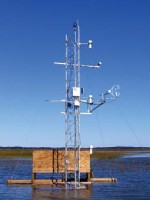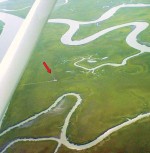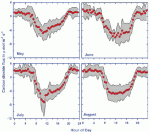In April 2007 a flux tower was established at the Virginia Coast Reserve (VCR) LTER to investigate the environmental forcings that influence carbon and energy exchanges between the local salt marsh and overlying atmosphere. The new flux tower will make it possible to understand and quantify the long-term processes governing the fluxes of materials in and out of tidal estuary systems. The salt marsh ecosystem exists at the interface between terrestrial and aquatic ecosystems.
The eddy covariance-based flux tower was established in a lagoonal salt marsh (Figure 1) at the Eastern Shore of Virginia. The site is dominated by Spartina alterniflora (smooth cord grass). The flux tower (Figure 2) includes various instruments to study the assimilatory response of the local ecosystem to changing environmental forcings. The relatively large tidal amplitude, coupled with short vegetation, provides an interesting scenario where the plant canopy can be completely submerged at various times of the day, thus providing an ideal setting for understanding the ecosystem-level response and function due to submergence.
Instruments deployed on the tower are interfaced with data loggers that are controlled by a data acquisition system. The system and associated instruments are powered by a battery bank kept charged by solar panels. The data acquisition system allows large data storage and is connected to VCR LTER's existing wireless network. The wireless connectivity allows for real-time data monitoring and system troubleshooting. All instruments on the tower allow the determination of fluxes of energy, water vapor, and carbon dioxide. The data obtained so far reveal strong seasonal trends in carbon assimilation patterns (Figure 3). Fluxes reached maximum values in July, coinciding with the maximum vegetation growth, and decreased in August, indicating the onset of plant senescence. Compared to other ecosystems, the magnitude of carbon assimilation indicates that the salt marsh contributes substantially to the removal of atmospheric carbon dioxide.
The resulting data sets show that the salt marsh ecosystem provides a unique opportunity for developing numerical models to investigate carbon sequestration by the ecosystem in response to current and future conditions. In particular, the data sets allow scientists to study ecosystem functions in response to perturbations caused both by storms and sea-level rise. Research is now underway to develop an integrated model incorporating a hydrodynamic module coupled with a transport module for simulating the air-sea carbon transfer, and a process based biophysical module for determining the carbon exchange from the Spartina alterniflora canopy. The study is expected to advance our understanding of the ecological processes taking place in these terrestrial-oceanic interfaces, which are susceptible to sea-level rise and climate change.

 Enlarge this image
Enlarge this image

